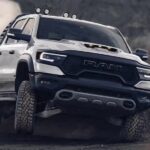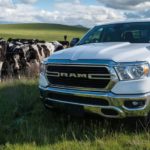It seemed like it was only yesterday when it was announced that RAM would separate itself from the Dodge brand. While brands have joined and been separated throughout history in various businesses, this one was slightly different. It wasn’t because of a corporate merger or hostile takeover but because of a genuine effort to repurpose focus in terms of manufacturing. Dodge would continue manufacturing SUVs and their highly-coveted muscle cars, while RAM would primarily focus on the pickup truck. The results have certainly been favorable for both brands. But for those who might not have been familiar with RAM until recently or have forgotten that the RAM 1500 was a creation of Dodge at one point, we’re here to turn back the clocks of history and examine how this exceptional vehicle evolved from humble beginnings into the workhorse we’re all familiar with today. This is a story of perseverance and determination. However, seeing the results that have come to fruition won’t be at a theater near you but rather at any new or used RAM dealership.
1981-1993: Over a Decade of Decadence
The 1980s were an exciting time in the truck world. In fact, some of the more iconic models that are still in production today made their debut during this period. While the pickup truck has always been associated with domestic brands, imports from Japan began to make their way over, prompting Ford to introduce their Ranger in 1983 to compete. However, the RAM’s story began two years earlier, in 1981, with a new lineup of trucks and vans introduced as part of their “D” line. This was the brainchild of none other than Lee Iacocca, who was president of Chrysler at the time and personally responsible for many major innovations in the American automotive world.
For all intents and purposes, the vehicle looked tough, which is certainly something that’s continued to the present day. The first RAM designs featured a squared-off front grille that made an impressive statement, and for the time, these first-generation Dodge Ram trucks had the engine power to back up their mean appearance. In 1989, while the Dodge Ram was still in its first generation of production, a diesel-fueled powertrain manufactured by Cummins made its first appearance, so potent and ahead of its time that it’s still found on many RAM trucks today. While we commonly associate high torque with modern diesel engines, the first one to find its way under the hood of a RAM generated 400 lb-ft, an admirable amount for a six-cylinder.
Of all of the engines employed by Dodge at this time, it was the Magnum 5.9L V8, which appeared in the final year of the truck’s first generation, that granted the Ram its highest rating of power, propelling it forward with 230 hp and generating 325 lb-ft of torque. But, as we’ll soon see, there’s always room for improvement.
1994-2001: A New Decade, A New Generation, The Same Rugged Dependability
As the 1990s rolled around, some remarkable changes took place in the world of pickup trucks. Items like the bench seat and three- and four-speed automatic transmissions would soon be relegated to the past in favor of emerging creature comforts and refined powertrains. It was in 1994 when the second generation of the Dodge RAM 1500 emerged to great acclaim. One of the most notable changes to the truck was its bold new design, based on some of the big rigs and semi trucks of the time amid a market of sleeker, sedan-like pickup trucks. With a big-rig-style front end and a prominent grille, this “macho” design proved popular with consumers, aptly describing these kinds of trucks as “knights of the highway.” The new design exerted toughness and allowed the vehicle to stand out among the other offerings from Ford and Chevy.
The design of the second-generation Dodge Ram 1500 got one of its most notable upgrades during the 1998 model year when Dodge introduced what they referred to as the Quad Cab. This consisted of smaller rear doors behind the main passenger doors, making multiple seating arrangements possible without having a full-sized crew cab. This design remained in place until the 2002 model year and was a unique feature many enjoyed. More than just body and exterior design, the Dodge RAM 1500 also displayed a relentless level of raw power in the form of a new Cummins diesel engine, which now generated 460 lb-ft of torque, a specification that’s still impressive by today’s standards. Always known for appealing to those who favored performance above all else, a six-speed manual transmission was offered even while four-speed automatic setups were still utilized during this period.
2002-2010: Enter the HEMI and the Final Years with Dodge
As the early 2000s began, the Dodge RAM 1500 had some formidable adversaries who were getting ready to offer some of its stiffest competition yet. The Chevy Silverado 1500 debuted in 1999, and the Ford F-150 was about as strong as ever. In response, Dodge did what they had done since their formative years; they adapted to these changes by refining their design in reference to the past while others raced for the future.
The refinement was an all-encompassing job, with the exterior being made much smoother and the truck’s frame getting wholly overhauled but still keeping that distinct look from the previous generation. Rack-and-pinion steering and an independent front suspension were also included to increase the vehicle’s capabilities. However, it was in 2003 that the Dodge Ram got one of its most significant upgrades. The 5.9L Magnum engine, which had been a staple of the Ram 1500 for many years, was replaced by a familiar namesake… HEMI. A name well-known to fans of the muscle car, the 5.7L HEMI V8 equipped the Dodge RAM with 345 hp and the ability to generate 375 lb-ft of torque. Since then, there’s been no other return to prominence more celebrated.
2010- Present: The Eagle (or RAM) Leaves its Nest
And so, we arrive at one of the most pivotal years for the Dodge Ram—or, instead, the RAM. In 2010, RAM officially separated from Dodge. The Dodge Ram 1500 simply became the RAM 1500, retaining the innovation and prowess it had spent the past several years developing, just with a new name. Aside from continuing to offer the very potent 5.7L HEMi V8, RAM now offers a versatile V6 engine in the form of the 3.6L Pentastar. The RAM also underwent some unique stylistic changes, placing a new-found emphasis on comfort, such as ventilated seats and a stylish interior that could be traced to the company’s inclusion within the Stellaris Automotive Group. Technological innovations followed, such as the Uconnect software system and a mild hybrid setup that the brand refers to as eTorque. These innovations, which RAM continues to develop, show a process of evolution that rivals any other in the modern automotive industry.
RAM Looks to the Future
So, where does the RAM 1500 go next? The expected answer from the average person to this would be, “Who knows?” However, as we’ve seen today, the RAM 1500 is the farthest thing from average, and no single article could come close to describing its evolution over the years. It’s safe to say that in the years ahead, the RAM 1500 will do what it’s done from the very beginning: change the way we conceptualize the pickup truck and evoke that power from the past that so many manufacturers have started to forget. No matter where it goes from here, our interest and excitement are along for the ride.




